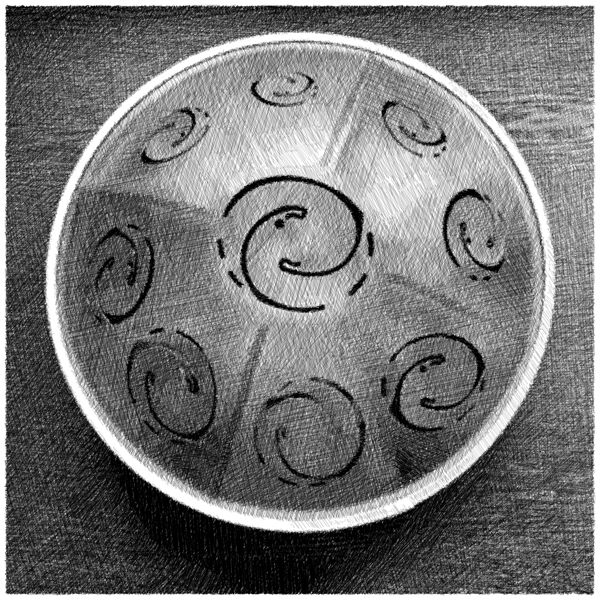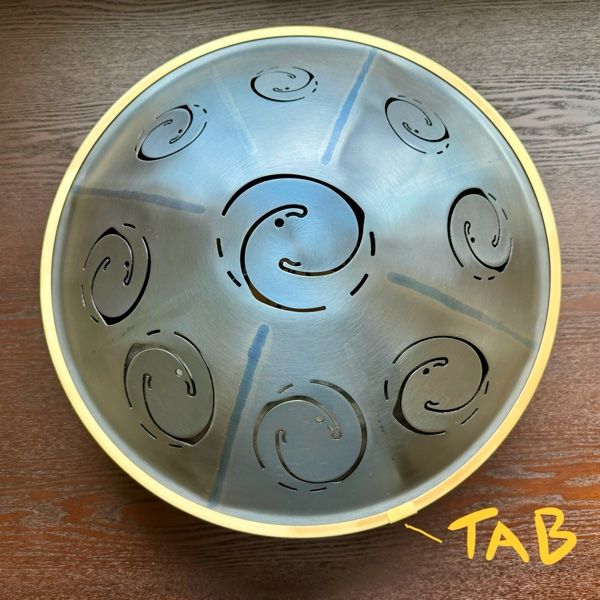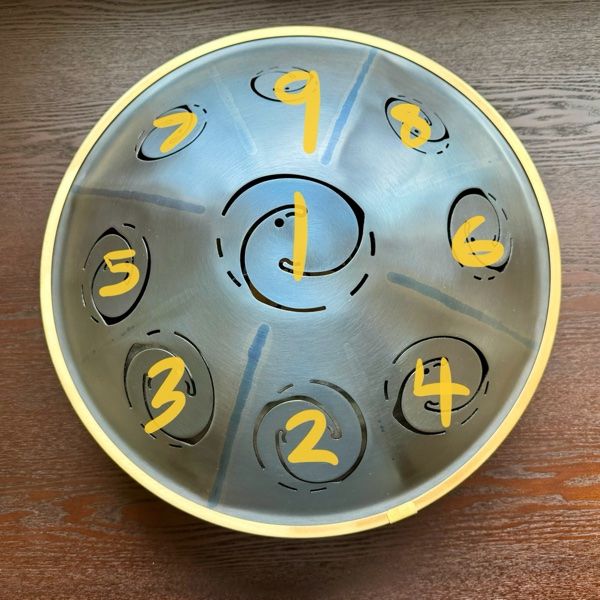
Rav Moon tongue drum: A beginners guide.
If you are lucky enough to play a Rav Moon as your first serious idiophone, this article is for you. This covers fundamentals of playing as they apply specifically to the Moon.
How to hold the Rav Moon.

Put the Moon in your lap. There’s a tab in the rim noted in the photo above. Position the Moon so the tongue to the left of the tab is pointing straight down. The lowest-pitched tongue in the circle is now the closest to you with notes ascending left, then right to the top. Tilt the Moon slightly forward for more comfortable playing. The Moon can also be placed on a stand like the Meinl or you can make your own tripod out of sticks, bamboo or PVC.
How to play with hands.

Mallets are easier to play with, but for a broader range of techniques, play with your fingertips, thumbs, knuckles, etc. The red spots in the photo above show areas of the hand players commonly use to strike. You can use the index, middle or ring finger, but as you get more advanced index fingers are the most useful for a wider variety of techniques. There’s no reason why you shouldn’t develop index, middle and ring. Clean hits with your hands come from tapping quickly, as if the Moon is hot.

Starting out, it’s best to work ergonomically: Play the ting (center tongue) and bottom three notes of the circle with your thumbs and the top five notes with the pads of your fingers. No matter how you hit the Moon, practice alternating hands on their side of the drum. This makes for better ergonomics, improves your accuracy and helps develop both hands equally. You certainly can use your right hand to play on the left side of the drum (or vice versa) but learning to play ergonomically will keep you from straining.
Where to strike the tongues on the Rav Moon.

You’ll notice that the orientation of the complex-shaped tongues rotate as you go around the Moon. You’ll need to take this into account as to where you strike the tongue. The tongue can be struck in different places to get different pitches and blooms. Here are the basics:
- Strike the red spot for the fundamental tone. This gives you the loudest note, the longest sustain and the characteristic bloom.
- Strike the blue spot for the overtone. It’s the same note, but de-emphasizes the fundamental tone to reveal overtones.
- A nice cheat: If you’re having issues getting notes to sound or getting consistent volume in the beginning, try tapping so the pad of your finger hits both the edge of the tongue and the shell.
- Gently rest your finger on the blue spot as you strike the red spot to dampen the sustain and minimize bloom. If you strike and then remove your finger from the blue spot the bloom will not be as intense.
- Use ghost notes. These are percussive taps that help keep rhythm but don’t sound any clear pitch. They’re most often played on the shell, but can also be played on muted tongues. Try them both with knuckle taps and basic strikes. They can be quick taps or held.
Excercises to build skill fast.
- Play softly. Of all the tongue drums and handpans, the Rav Moon is designed to need the least amount of energy to generate sound. Listen to the difference between a loud and hard hit. The softer you play, the more beautiful the sound. If you’re getting any amount of harshness, loud percussive hits or sympathetic bleed (one tongue being hit so hard it causes undesirable tones from other tongues through sympathetic vibration of the shell) you’re probably expending too much energy. Likewise, Ghost notes can require restraint and shouldn’t overshadow the normal notes.

- Play with the scale alternating hands. The ascending scale is noted above. While a simple exercise, this is the fastest way to master control of the tongue drum. Go down the scale to. Play with the fingers/thumbs as well as with knuckle taps on the tongues.
- Play the scale using just the overtones by striking the blue area. The Moon’s complex tongues make them expressive and mastering overtones gives you an additional octave.
- Work on getting consistent volume for each tongue. With the same amount of energy tapped, the center tongue will be louder than the highest tongue. So tapping the ting softer and the highest tongue harder will get you more even volume between notes. Once you’ve mastered a consistent volume for all tongues, you’ll have the skills to add more controlled volume to your playing. Playing each tongue slowly with alternating index fingers helps to develop consistency in your strikes.
- Work on striking tongues so they don’t thump. A delay is a great way to practice this.
- Practice ghost notes to develop rhythm. Many players use ghost notes to keep a steady rhythm. In a four-beat pattern, try tapping the note on 1 and ghost notes on 2, 3 and 4. Or to get more complex with a three-beat pattern, make the rhythm eighth notes: 1, 2-3, 1 2-3.
How to play well with others.
The Rav Moon is a percussive as well as melodic instrument set to one key and one scale. It works well with other percussive instruments, but melodic instruments, will need to be in your key (flute, didgeridoo) or adapt to your key (guitar).
My take.
These are just the basics. Mastering the Rav Moon is a continual learning process. Experiment your own techniques to make your playing unique. My philosophy is to learn best practices and deviate from them when you have good reason.
Interested in more Rav Moon and tongue drum posts? Consider supporting more content by buying me a coffee below.
